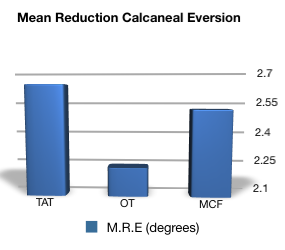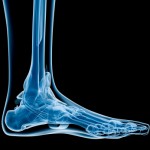Introduction
On a daily basis sports physiotherapists assess and diagnose in an attempt to establish contributors to injury. When assessing lower limb injuries one of the most common offenders seems to be excessive dynamic pronation. This is a topic that has been discussed quite a few times on this site:
- Prevention of Lower Limb Overuse Injuries with Orthotic Therapy
- Treating Patellofemoral Pain With Orthotics: Research Review
- Intrinsic Foot Muscle Strengthening: A Comparison of Short Foot and Toe Curl Exercises
This article will discuss the effectiveness of various external controls in preventing excessive pronation.
What Is Pronation?
Now, this should not come as a surprise to anybody but foot pronation is in fact a very normal motion of the foot. It is required for shock absorption during normal walking and running gait.
Pronation is a triplanar movement and is the combination of rearfoot eversion, midfoot abduction and talocrural dorsiflexion.
As you know this movement is required during stance phase to allow for normal patterning. Pronation is not always evil! However, where we get into trouble is when there is excessive pronation. Excessive pronation does have horns.
Why Do We Want To Prevent Excessive Pronation?
There are obvious reasons why a sports physiotherapist would want to limit excessive pronation in an athlete. Excessive foot pronation has been shown to be correlated with the incidence of the following (to name but a few):
- Metatarsal stress fracture (Mazrahi et al., 2000)
- Plantar fasciitis (Pascual Huerta et al., 2008)
- Achilles tendinopathy (McCrory et al., 1999)
- Patellar tendinopathy (van der Worp et al., 2011)
- Medial tibial stress syndrome (Moen et al., 2009)
- Patellofemoral pain (Cheung et al., 2007)
As I stated above this is just to name a few. I could go on, however, it is fairly obvious that it is necessary that we design appropriate interventions that will prevent excessive dynamic pronation in our athletes. It is common is sports physiotherapy practice to utilise taping techniques, orthoses or motion control footwear as a component of an over-pronation management program (Cheung et al., 2011).
However, do you know what devices of these are the most effective and controlling excessive pronation?
New Research Into “Anti-pronation Devices”
A recent meta-analysis by Cheung and colleagues (2011) evaluated the effectiveness of different ‘external controls’ for controlling excessive pronation. Whilst the authors struggled to find high quality RCT’s, as the average PEDro Score of the included studies was approximately 5.4/11, 29 studies met the inclusion criteria and a total of 486 subjects were included in the analysis. This allowed the authors to compare the efficacy of a number of interventions for preventing excessive pronation. These included:
- Therapeutic Adhesive Taping (including Low-Dye and High-Dye taping techniques)
- Foot Orthoses (including custom moulded and prefabricated)
- Motion Control Footwear
The authors were also able to draw conclusions on the effectiveness of individual techniques i.e. low-dye vs. high-dye taping. The main outcome assessed was mean reduction in calcaneal eversion i.e. the most easily assessed component of pronation. The results are shown graphically below:
Thus, the results show that the all 3 options were similarly effective for controlling rear-foot motion, as you will notice only about 0.5 degree difference between them. This may simply be a measurement error due to the lower quality of included studies.
Additionally, the authors were able to evaluate subsections of the devices. What should come as no surprise is that the authors found that custom orthoses were more effective than prefabricated orthoses (but only by about 0.27 degrees). What may surprise some physiotherapists is that the studies showed that low-dye taping produced no statistically significant change in calcaneal eversion. This is striking given that low-dye taping is one of the most popular techniques among clinicians. This supports the findings of a systematic review which showed low-dye taping produced no significant changes in rear-foot motion and only small changes in navicular height (Radford et al., 2006). However, other techniques (high-dye and stirrups) were quite effective in controlling pronation (mean change=4.62°). The effectiveness of taping techniques over a period of time was not evaluated, and should be questioned.
Clinical Implications of This Research
- There was a lack of high-quality randomised controlled trials in this area, despite the fact that they are feasible. Thus, the findings should be taken with caution
- The 3 options were similarly effective for controlling rear-foot motion (particularly if you exclude low-dye taping)
- The authors suggest the selection of anti-pronation intervention should be based on individual patient characteristics, type of activity and personal preference
- If you are going to utilise taping to control excessive pronation; high-dye or stirrup techniques seem more effective
What are your thoughts on this new research? Be sure to let me know in the comments or catch me on Facebook or Twitter
If you require any sports physiotherapy products be sure check out PhysioSupplies (AUS) or MedEx Supply (Worldwide)
References
Cheung RTH, Ng GYF. A systematic review of running shoes and lower leg biomechanics: a possible link with patellofemoral pain syndrome? Int Sport Med J 2007;8:107–16.
Cheung RTH, Ng GYF. Efficacy of motion control footwears for reducing excessive rearfoot motion in fatigued runners. Phys Ther Sports 2007; 8 :75–81.
Cheung RTH, Chung RCK, Ng GYF. Efficacies of different external controls for excessive foot pronation: a meta-analysis. Br J Sports Med 2011;45:743–751.
McCrory JL, Martin DF, Lowery RB, et al. Etiologic factors associated with Achilles tendinitis in runners. Med Sci Sports Exerc. 1999;31:1374-1381.
Mizrahi J, Verbitsky O, Isakov E. Fatigue-related loading imbalance on the shank in running: a possible factor in stress fractures. Ann Biomed Eng 2000;28:463–9.
Moen MH, Tol JL, Weir A, et al. Medial tibial stress syndrome: a critical review. Sports Med 2009;39:523–46.
Moss CL, Gorton B, Deters S. A comparison of prescribed rigid orthotic devices and athletic taping support used to modify pronation in runners. J Sport Rehabil 1993; 2 :179–88.
Pascual Huerta J, García JM, Matamoros EC, et al. Relationship of body mass index, ankle dorsiflexion, and foot pronation on plantar fascia thickness in healthy, asymptomatic subjects. J Am Podiatr Med Assoc 2008;98:379–85.
Radford JA, Burns J, Buchbinder R, Landorf KB, Cook C. The effect of low-dye taping on kinematic, kinetic, and electromyographic variables: a systematic review. J Orthop Sports Phys Ther. 2006;36(4):232-41.
Van der Worp H, van Ark M, Roerink S et al. Risk factors for patellar tendinopathy: a systematic review of the literature. Br J Sports Med 2011 45: 446-452.
Related Posts
Comments











How come people eg(women over 50) with pronation have week adducting muscles Has anyone thought about the power house ubove the knee
Hi Jenene,
Thanks for your feedback. Recently, more than ever has it been shown that addressing all the dysfunctional components of the kinetic chain is important for an optimal result. You are right to suggest that the powerhouse above the knee is likely just as important to what is below. That very fact is discussed in this article about an intervention for Patellofemoral Pain Syndrome. Thanks again.